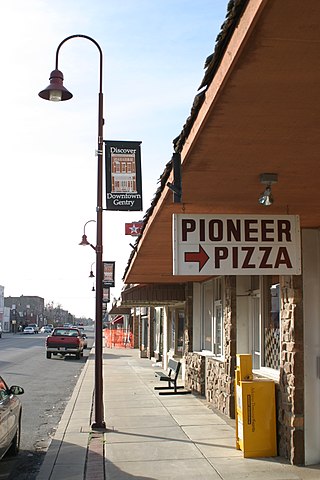
Gentry is a city in Benton County, Arkansas, United States. The population was 3,790 as of the 2020 census. The city was founded in the Ozark Mountains in 1894 along what would become the Kansas City Southern Railroad. The city's prior prosperity in the orchard industry, especially apples, was further strengthened by the rail connection. Following the decline of the apple industry in the 1930s, Gentry shifted its economy towards poultry along with many other areas of Northwest Arkansas.

Siloam Springs is a city in Benton County, Arkansas, United States, and located on the western edge of the Northwest Arkansas metropolitan area. As of the 2020 census, the population of the city was 17,287. The community was founded in 1882 and was characterized by the purported healing powers of the spring water feeding Sager Creek and trading with nearby Native American tribes. The city shares a border on the Arkansas–Oklahoma state line with the city of West Siloam Springs, Oklahoma, which is within the Cherokee Nation territory. It is home of John Brown University.

West Siloam Springs is a town in Delaware County, Oklahoma, United States. The population was 1,000 at the 2020 census, an 18.2 percent increase from the figure of 846 recorded in 2010. A bedroom community for Siloam Springs, Arkansas, it is notable for its Cherokee casino, and is the closest town to Natural Falls State Park.

Arkansas Highway 16 is a designation for three state highways in Arkansas. One segment of 24.13 miles (38.83 km) runs from U.S. Route 412 in Siloam Springs east to Interstate 49 (I-49) in Fayetteville. A second segment of 71.67 miles (115.34 km) runs from I-49 in Fayetteville east to Highway 7 in the Ozark National Forest. A third segment of 132.69 miles (213.54 km) runs from Highway 7 at Sand Gap east to US 67B in Searcy. Highway 16 was created during the 1926 Arkansas state highway numbering, and much of the highway winds through the Ozarks, including the Ozark National Forest, where a portion of it is designated as an Arkansas Scenic Byway. The route has two spur routes in Northwest Arkansas; in Fayetteville and Siloam Springs.
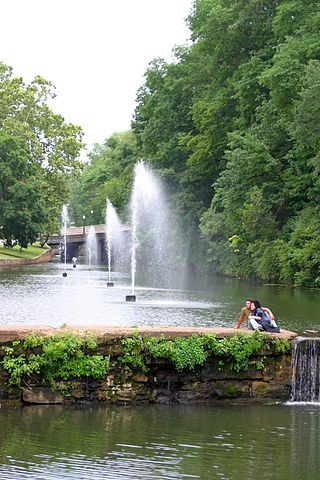
Sager Creek is a 13.4-mile-long (21.6 km) creek which runs through downtown Siloam Springs, Arkansas, in the United States. It is a tributary of Flint Creek, which flows to the Illinois River, which in turn flows to the Arkansas River and thus is part of the Mississippi River watershed. Sager Creek is named after the man largely thought to be the founder of Siloam Springs, Simon Sager.
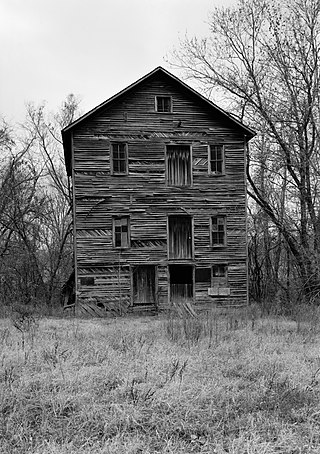
The Hildebrand Mill on Flint Creek in Colcord, Delaware County, Oklahoma was built c. 1845 and served hill people of the Old Cherokee Nation territory for more than 125 years. It is located not far from Siloam Springs, Arkansas. It was listed on the National Register of Historic Places in 1972.
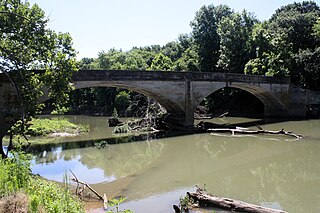
The Illinois River Bridge, also known as the Midway Bridge, is a historic concrete arch bridge near Siloam Springs, Arkansas. It is located in Ozark National Forest, about 6 miles (9.7 km) east of Siloam Springs, at the end of Chambers Springs Road south of United States Route 412. The bridge has two elliptical arch spans, each spanning 68 feet (21 m), with a total structure length of 139 feet (42 m). Built in 1922 by the Luten Bridge Company of Knoxville, Tennessee, it is one of a modest number of bridges of this once-popular and common type remaining in the state.

The Alfrey-Brown House is a historic house located at 1001 South Washington Street in Siloam Springs, Arkansas, United States.

The Fred Bartell House is a historic house at 324 East Twin Springs Street in Siloam Springs, Arkansas. Built c. 1900, it is a 2+1⁄2-story wood-frame structure, with asymmetrical massing typical of the Queen Anne style. It has a low octagonal turret at the front left, and a porch, supported by Tuscan columns mounted on a lattice of concrete blocks that form a low balustrade. The house is clad in novelty siding.
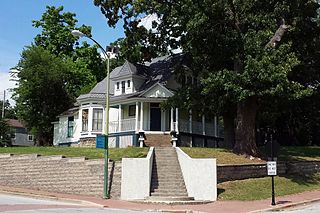
The Bratt-Smiley House is a historic house at University Street and Broadway in Siloam Springs, Arkansas.

The Carl's Addition Historic District is a predominantly residential historic district in Siloam Springs, Arkansas. The area was developed between about 1895 and 1945, a period of growth brought about by the arrival of the railroad. It contains a concentration of Queen Anne and Craftsman style houses, although other popular revival styles are also represented to some degree. The district extends along South Wright Street between Twin Springs and Alpine Streets, and for single blocks along West Alpine and South College Streets.

The Connelly-Harrington House is a historic house at 115 East University Street in Siloam Springs, Arkansas.

The Duckworth-Williams House is a historic house at 103 South College Street in Siloam Springs, Arkansas. It is a two-story stuccoed brick building, with a side gable roof that has a wide shed-roof dormer on the front. The roof extends across the front porch, which is supported by four stuccoed brick columns. The side walls of the house have half-timbered stucco finish. Built c. 1910, this is the only Tudor Revival house in Siloam Springs.

The First National Bank is a historic commercial building at 109 East University Street in Siloam Springs, Arkansas. It is a two-story brick building, trimmed in stone. Its ground floor is recessed in an arcade supported by square posts, and is separated from the second floor by a stone belt course. The upper floor windows have round stone arches, with two narrow bays projecting slightly. The cornice has corbelled brickwork, and is topped in a few places by stone caps. The building is Siloam Springs' only significant example of Romanesque Revival architecture.
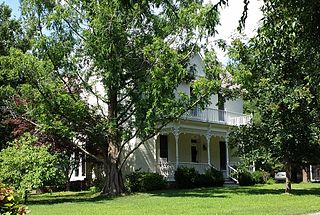
The German Builder's House is a historic house at 315 East Central Street in Siloam Springs, Arkansas. It is a two-story brick I-house, with a side gable roof and a rear wood-frame addition, giving it an overall T shape. A porch with open veranda above spans most of the width of the main facade, with Queen Anne style turned posts and balusters, and a spindled frieze. The house was built c. 1880 by German masons from St. Louis who were working on a nearby school building. It is one of the finest brick I-houses in Benton County.

The Henry Furniture Store Building is a historic commercial building at 107 West University in Siloam Springs, Arkansas. It is a single-story brick building, with an angled recessed storefront topped by a raised brick parapet set above brick corbelling and a pressed metal cornice. Built c. 1900, it is the best example in the city of commercial architecture from that time period.

The Crown Hotel, formerly the Lakeside Hotel is a historic hotel building at 119 West University Street in Siloam Springs, Arkansas. It is a two-story brick building in an L shape, with a hip roof topped by a low cupola. It is distinguished by the brickwork at the roofline, and by the delicately spindled two-story porch that wraps around two sides of the building. Built in 1881, just one year after the city's founding, it is one of the city's oldest commercial buildings, and may have been its first brick hotel.

The Quell House is a historic house at 222 South Wright Street in Siloam Springs, Arkansas. It is a 1+1⁄2-story Craftsman bungalow with a shallow-pitch side gable roof, and a front gabled porch extending across the front which is supported by stuccoed piers. The gables have deep eaves and exposed rafter ends. The walls are finished in stucco that had a gravel-like material thrown against it while wet, giving it a rough and textured surface. Built c. 1920, it is a fine local example of the Craftsman/bungalow style.

The Simon Sager Cabin is a historic log cabin on the campus of John Brown University in Siloam Springs, Arkansas. It is the oldest permanent structure in Siloam Springs. The cabin was listed on the National Register of Historic Places in 1976.

The Siloam Springs Downtown Historic District encompasses the historic downtown area of Siloam Springs, Arkansas. The district is roughly bounded by University Street, Broadway, and Sager Creek, with a few buildings on adjacent streets outside this triangular area. This business district was developed mainly between about 1896, when the railroad arrived, and 1940, and contains a significant number of buildings dating to that period. It also includes Siloam Springs City Park, the location of the springs that gave the city its name. Notable buildings include the First National Bank building, a c. 1890 Romanesque Revival building, and the c. 1881 Lakeside Hotel, which is one of the city's oldest commercial buildings.





















